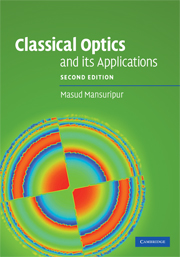Book contents
- Frontmatter
- Contents
- Preface to the second English edition
- Preface to the first edition
- Introduction
- 1 Abbe's sine condition
- 2 Fourier optics
- 3 Effect of polarization on diffraction in systems of high numerical aperture
- 4 Gaussian beam optics
- 5 Coherent and incoherent imaging
- 6 First-order temporal coherence in classical optics
- 7 The van Cittert–Zernike theorem
- 8 Partial polarization, Stokes parameters, and the Poincaré sphere
- 9 Second-order coherence and the Hanbury Brown–Twiss experiment
- 10 What in the world are surface plasmons?
- 11 Surface plasmon polaritons on metallic surfaces
- 12 The Faraday effect
- 13 The magneto-optical Kerr effect
- 14 The Sagnac interferometer
- 15 Fabry–Pérot etalons in polarized light
- 16 The Ewald–Oseen extinction theorem
- 17 Reciprocity in classical linear optics
- 18 Optical pulse compression
- 19 The uncertainty principle in classical optics
- 20 Omni-directional dielectric mirrors
- 21 Linear optical vortices
- 22 Geometric-optical rays, Poynting's vector, and the field momenta
- 23 Doppler shift, stellar aberration, and convection of light by moving media
- 24 Diffraction gratings
- 25 Diffractive optical elements
- 26 The Talbot effect
- 27 Some quirks of total internal reflection
- 28 Evanescent coupling
- 29 Internal and external conical refraction
- 30 Transmission of light through small elliptical apertures
- 31 The method of Fox and Li
- 32 The beam propagation method
- 33 Launching light into a fiber
- 34 The optics of semiconductor diode lasers
- 35 Michelson's stellar interferometer
- 36 Bracewell's interferometric telescope
- 37 Scanning optical microscopy
- 38 Zernike's method of phase contrast
- 39 Polarization microscopy
- 40 Nomarski's differential interference contrast microscope
- 41 The van Leeuwenhoek microscope
- 42 Projection photolithography
- 43 Interaction of light with subwavelength structures
- 44 The Ronchi test
- 45 The Shack–Hartmann wavefront sensor
- 46 Ellipsometry
- 47 Holography and holographic interferometry
- 48 Self-focusing in nonlinear optical media
- 49 Spatial optical solitons
- 50 Laser heating of multilayer stacks
- Index
- References
37 - Scanning optical microscopy
Published online by Cambridge University Press: 31 January 2011
- Frontmatter
- Contents
- Preface to the second English edition
- Preface to the first edition
- Introduction
- 1 Abbe's sine condition
- 2 Fourier optics
- 3 Effect of polarization on diffraction in systems of high numerical aperture
- 4 Gaussian beam optics
- 5 Coherent and incoherent imaging
- 6 First-order temporal coherence in classical optics
- 7 The van Cittert–Zernike theorem
- 8 Partial polarization, Stokes parameters, and the Poincaré sphere
- 9 Second-order coherence and the Hanbury Brown–Twiss experiment
- 10 What in the world are surface plasmons?
- 11 Surface plasmon polaritons on metallic surfaces
- 12 The Faraday effect
- 13 The magneto-optical Kerr effect
- 14 The Sagnac interferometer
- 15 Fabry–Pérot etalons in polarized light
- 16 The Ewald–Oseen extinction theorem
- 17 Reciprocity in classical linear optics
- 18 Optical pulse compression
- 19 The uncertainty principle in classical optics
- 20 Omni-directional dielectric mirrors
- 21 Linear optical vortices
- 22 Geometric-optical rays, Poynting's vector, and the field momenta
- 23 Doppler shift, stellar aberration, and convection of light by moving media
- 24 Diffraction gratings
- 25 Diffractive optical elements
- 26 The Talbot effect
- 27 Some quirks of total internal reflection
- 28 Evanescent coupling
- 29 Internal and external conical refraction
- 30 Transmission of light through small elliptical apertures
- 31 The method of Fox and Li
- 32 The beam propagation method
- 33 Launching light into a fiber
- 34 The optics of semiconductor diode lasers
- 35 Michelson's stellar interferometer
- 36 Bracewell's interferometric telescope
- 37 Scanning optical microscopy
- 38 Zernike's method of phase contrast
- 39 Polarization microscopy
- 40 Nomarski's differential interference contrast microscope
- 41 The van Leeuwenhoek microscope
- 42 Projection photolithography
- 43 Interaction of light with subwavelength structures
- 44 The Ronchi test
- 45 The Shack–Hartmann wavefront sensor
- 46 Ellipsometry
- 47 Holography and holographic interferometry
- 48 Self-focusing in nonlinear optical media
- 49 Spatial optical solitons
- 50 Laser heating of multilayer stacks
- Index
- References
Summary
The diffraction-limited focusing of a laser beam to either explore or modify a surface is the basis of several important technologies. Examples include scanning optical microscopy, optical disk data storage, and laser printing. The size of the focused spot and the corresponding depth of focus are important factors in determining the performance characteristics of these systems. In this chapter we examine methods of forming the focused spot, and clarify the relation between spot size and depth of focus.
Principle of operation
The essential features of a scanning optical microscope are shown in Figure 37.1. A laser beam is sent through an objective lens to form a focused spot on the sample. Ideally, the objective is corrected for all aberrations, yielding a diffraction-limited focused spot. The light reflected from the sample returns through the objective and is redirected by the beam-splitter to a detection module. The detection module may be designed to monitor the power, the phase, or the polarization state of the returning beam. The electrical signal S(x, y) produced by the detector is thus representative of the small area of the sample illuminated by the focused spot at and around the point (x, y). The sample is moved to different locations by the XY stage on which it is mounted; the signal S(x, y), plotted against the sample's position, yields an image of the sample's surface over the desired area.
- Type
- Chapter
- Information
- Classical Optics and its Applications , pp. 525 - 544Publisher: Cambridge University PressPrint publication year: 2009



